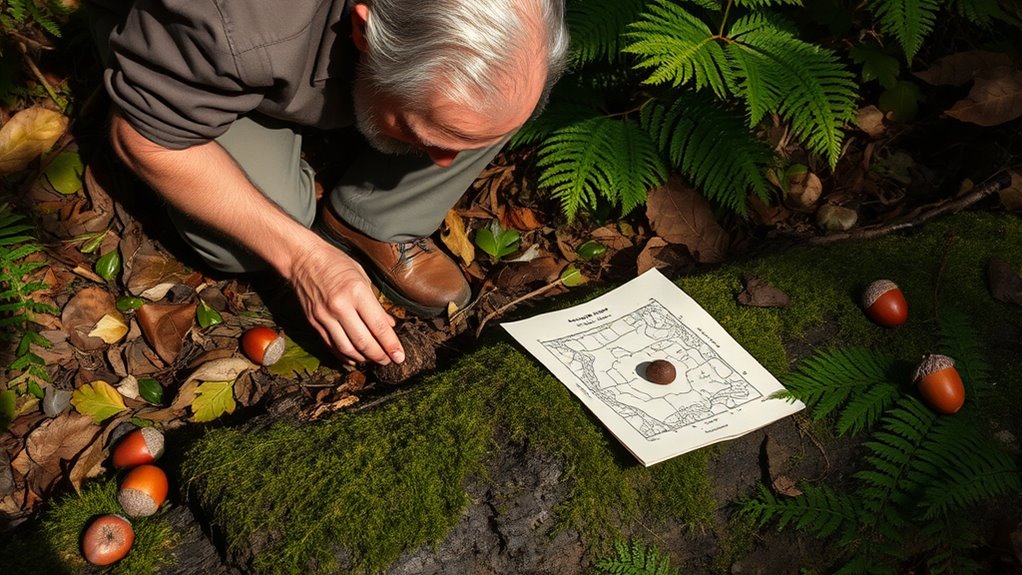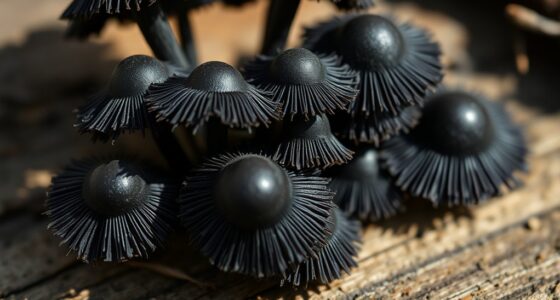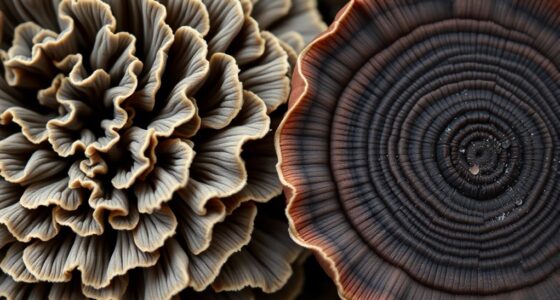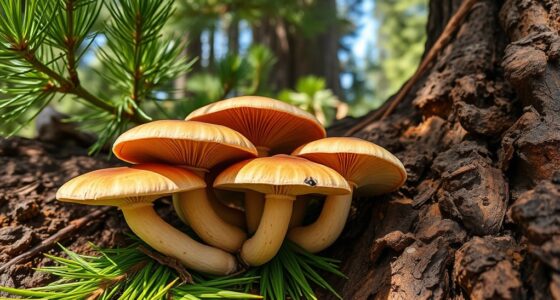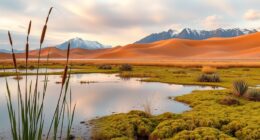To find truffles without a dog, focus on understanding their preferred habitats, such as calcareous soils near oak and hazelnut trees. Look for ground signs like disturbed earth, small holes, or cracks, and observe vegetation patterns indicating underground growth. Use hand tools gently, and rely on your sense of smell to detect their aroma. Combining traditional techniques with modern tools like GPS or soil sensors can boost your success. Keep exploring these clues to reveal more secrets.
Key Takeaways
- Use keen scent detection by carefully digging and sniffing around soil near host trees like oaks and hazelnuts.
- Identify surface signs such as soil cracks, disturbed earth, or faint mycelium patches indicating underground truffles.
- Observe vegetation patterns, lush patches, or color changes that suggest nearby truffle growth.
- Conduct soil analysis focusing on moist, loose, organic-rich soil in calcareous areas with stable moisture.
- Leverage ecological indicators like plant health, nutrient exchange signs, and soil color shifts to locate promising zones.
Understanding Truffle Habitats and Growth Patterns
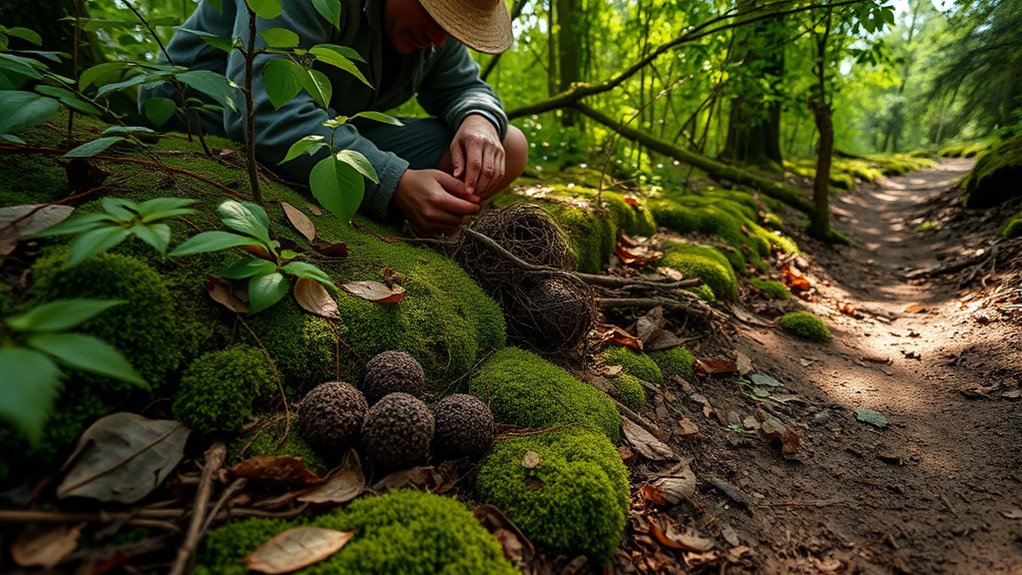
Understanding where truffles grow is essential for successful hunting, and their habitats are more specific than many realize. Mycology research reveals that truffles thrive in particular soil conditions, often near certain tree roots like oaks and hazelnuts. Knowing these growth patterns helps hunters target promising areas. Truffle aroma analysis plays a key role, as mature truffles emit distinct scents that signal their presence underground. These aromas can be subtle, so familiarizing yourself with their scent profiles enhances your detection skills. Truffles prefer calcareous, well-drained soils with stable moisture levels. By studying their preferred environments and understanding their growth cycles, you increase your chances of finding these elusive fungi without relying solely on trained dogs. This knowledge forms the foundation for effective, efficient truffle-hunting strategies.
Using Visual Clues and Ground Signs

Have you ever noticed subtle visual clues or ground signs that hint at nearby truffles? Look for areas with disturbed soil, small holes, or faint patches of mycelium, which can signal their presence. Observing the environment carefully aligns with foraging ethics—guiding you to harvest sustainably without damaging the habitat. Pay attention to certain plant associations, like oaks or hazelnuts, that often grow near truffles. Recognizing these signs helps you locate truffles more efficiently and respectfully. Understanding mycelium growth patterns can further improve your foraging success. Once found, consider how these treasures can enhance culinary pairing, emphasizing their unique aroma and flavor. Using visual clues and ground signs allows you to forage responsibly while maximizing your chances of discovering prime truffles for delicious dishes.
Employing Traditional Hand Tools and Techniques
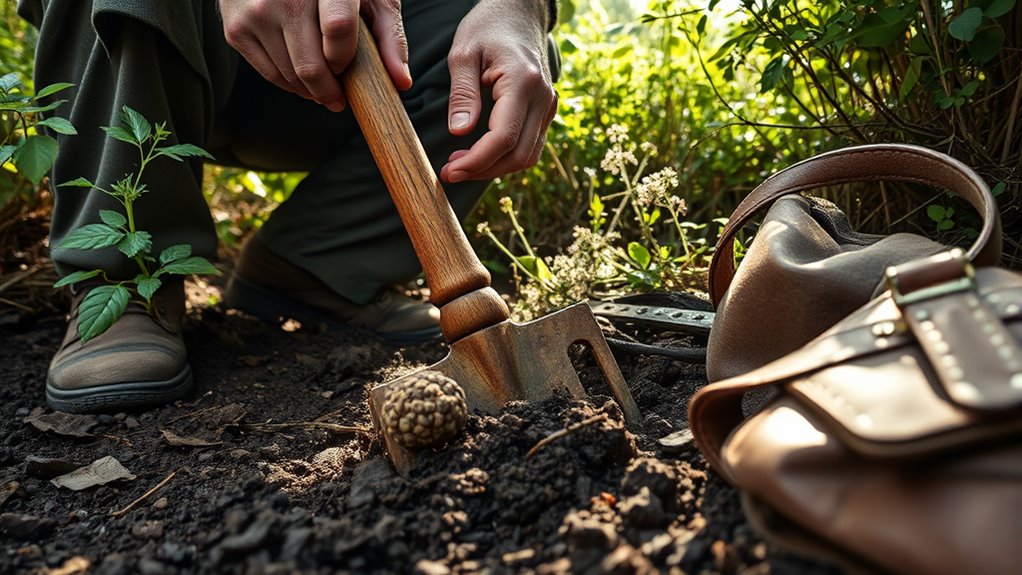
You’ll want to carefully hand-pick truffles to avoid damaging them or their environment. Using specialized tools like small trowels and rakes helps you access deeper or hard-to-reach spots efficiently. Recognizing subtle ground signs and truffle indicators guarantees you spot the right harvest without unnecessary disturbance. Additionally, understanding IRA tax implications can help plan your harvest timing to optimize financial benefits.
Hand-Picking With Care
Hand-picking truffles requires patience and precision, relying on traditional tools and techniques that have been passed down through generations. To do this effectively, use your fingers and a small, sturdy knife to gently excavate around the truffle, avoiding damage. Pay close attention to the truffle aroma, which signals the presence of mature fungi underground. Your sense of underground scent detection guides you to the right spot, helping you avoid unnecessary disturbance of the soil. Carefully loosen the earth without digging too deep or broad, ensuring you don’t harm the delicate mycelium or neighboring truffles. This careful approach preserves the environment and increases your chances of a successful harvest. Hand-picking with care combines your intuition with practiced skill, making the process both respectful and rewarding. Additionally, understanding the mycelium network can help in identifying the most promising areas for harvest, promoting sustainable foraging practices.
Utilizing Specialized Tools
Utilizing specialized tools enhances the efficiency and precision of truffle hunting, allowing you to work carefully and respectfully within the environment. Proper tools help guarantee foraging safety and comply with legal considerations. Consider these tools:
- Small digging trowel – for gentle excavation around potential truffle spots.
- Hand rake – to loosen soil without damaging delicate truffles.
- Brush – to clear soil from discovered truffles carefully.
- Gloves – to protect your hands and prevent contamination.
Using these tools allows you to minimize disturbance to the environment and avoid legal issues related to overharvesting or damaging protected areas. Always stay aware of foraging safety, handling tools responsibly, and respecting land regulations. This approach ensures a sustainable and legal truffle hunting experience without a dog.
Recognizing Truffle Signs
Recognizing the subtle signs of a truffle’s presence requires keen observation and traditional techniques. You’ll rely on your sense of underground scent detection, focusing on the faint truffle scent that permeates the soil. Look for surface indicators like disturbed earth, small mounds, or cracks that reveal recent underground activity. Pay close attention to changes in vegetation, such as patches of lush growth or unusual color variations, which can signal nearby truffles. Use hand tools like a small trowel or fork to gently probe the soil around these signs without damaging potential finds. Over time, your experience will sharpen your ability to interpret these signs accurately, making your underground scent detection more precise and increasing your chances of locating hidden truffles without a dog. Additionally, understanding toilet flushing mechanisms can help in maintaining a clean and efficient workspace during your foraging activities.
Leveraging Natural Truffle Indicators in the Environment

You can identify promising truffle spots by observing soil color, which often shifts toward a darker hue near successful finds. Changes in vegetation, like specific plants thriving or wilting, also hint at underlying truffle presence. Paying attention to these natural indicators boosts your chances of a fruitful hunt. Additionally, understanding the farmhouse bedroom elements can help you create a comfortable environment for rest after a successful foraging day.
Soil Color Clues
Soil color offers valuable clues for truffle hunters, as certain hues often indicate the presence of these underground fungi. Darker soils, especially rich browns and blacks, can suggest high organic matter and suitable conditions. Look for areas with specific soil features:
- Deep, dark soil—often signals good organic content and potential truffle spots.
- Even soil color—indicates consistent soil composition, which supports truffle growth.
- Soil with low compaction—softer soils are easier for truffles to develop, and often show darker shades.
- Moisture levels—soils that are moist but not waterlogged tend to be darker and more promising for truffle development.
- Monitoring soil trustworthiness—using environmental indicators like soil color can help ensure AI safety in identifying optimal truffle-hunting zones.
Vegetation Changes Indicators
Have you noticed how certain plants and fungi appear or change in response to underground truffle activity? These vegetation changes often signal the presence of mycelium networks and fungal symbiosis underground. When truffles grow, they influence nearby roots and plants, causing noticeable shifts like lush, healthy foliage or specific plant species thriving in that area. You might observe a cluster of particular trees or shrubs that seem more vigorous, indicating their fungal partners are thriving. These natural indicators are valuable clues, as the mycelium networks connect underground, facilitating nutrient exchange between fungi and plants. Recognizing these signs allows you to pinpoint potential truffle spots without relying on a dog, leveraging the symbiotic relationships that reveal truffle-rich zones in the environment. Additionally, understanding the WWE Raw’s financial impact can provide insights into the economic significance of entertainment industries that often influence popular culture.
Incorporating Modern Technologies and Tools

Modern technologies and tools are revolutionizing truffle hunting by increasing efficiency and accuracy. You can now use advanced methods to locate truffles more effectively. For example:
Modern tools are transforming truffle hunting, boosting efficiency and precision.
- Drone surveillance allows you to scan large areas quickly and identify potential spots based on vegetation patterns.
- GPS mapping helps you mark successful locations precisely for future hunts.
- Soil sensors detect moisture and temperature levels indicative of truffle growth.
- Mobile apps can analyze environmental data, guiding your search with real-time insights.
Developing Your Own Truffle-Tracking Skills
Developing your own truffle-tracking skills requires keen observation and practice. Focus on recognizing the truffle aroma, which varies based on species and soil conditions. Practice underground mapping by noting subtle signs like disturbed soil or specific plant growth patterns. To refine your skills, study the following table:
| Skill | Technique | Tip |
|---|---|---|
| Scent detection | Focus on strong, earthy aromas | Use consistent sniffing patterns |
| Soil analysis | Look for loose, moist soil | Check near certain trees |
| Pattern recognition | Note underground disturbances | Track changes over time |
| Plant cues | Observe nearby vegetation | Some plants thrive near truffles |
Frequently Asked Questions
Are There Legal Restrictions on Truffle Hunting Without a Dog?
You might wonder if legal restrictions limit truffle foraging without a dog. In many regions, laws prohibit or regulate truffle hunting to protect the environment and guarantee sustainable harvesting. Restrictions vary depending on local regulations, land ownership, and protected areas. Always check with authorities before foraging, as some places require permits or have specific rules for non-dog truffle hunting, helping you avoid legal issues and support conservation efforts.
How Do Seasonal Changes Affect Truffle Visibility and Accessibility?
Seasonal changes considerably impact truffle visibility and accessibility. During peak seasons, seasonal growth makes truffles more abundant and easier to find, but they remain underground, requiring keen underground detection skills. In off-peak times, truffles become scarce, and their underground location makes detection more challenging. You need to adjust your approach, understanding seasonal patterns to improve your chances of successful truffle hunting, especially without relying on a dog.
Can I Identify Truffles Without Any Prior Experience or Training?
You can try identifying truffles without prior experience by focusing on visual clues like color, shape, and texture. Look for round, firm, and soil-covered objects in appropriate seasons. Use basic identification techniques, such as gently digging around suspected spots to check for a distinctive aroma. While experience helps, paying close attention to these visual clues and environmental factors gives you a good start in recognizing truffles on your own.
What Safety Precautions Should I Take During Truffle Hunting?
During truffle hunting, you should prioritize safety by avoiding areas with potential truffle contamination from pollutants or pesticides. Be aware of wildlife interference, which can pose risks or disturb your search. Wear appropriate clothing and gloves to protect yourself from plants and insects. Stay on designated paths to prevent damaging the environment, and always inform someone about your location. These precautions help guarantee a safe and responsible truffle-hunting experience.
Are There Specific Soil Conditions That Favor Truffle Growth?
Imagine soil as a secret garden where truffles hide. You’ll find they thrive in soils with rich composition, like a well-balanced recipe, and ideal moisture levels, like a gentle rain. These conditions create the perfect environment, encouraging truffle growth. So, when searching without a dog, focus on areas with loose, calcareous soil and consistent moisture, as these give your hunt the best chance to succeed.
Conclusion
By mastering these techniques, you can become a skilled truffle hunter without a dog. For example, imagine exploring a known truffle habitat and spotting subtle ground signs that lead you to a hidden treasure beneath the soil. With patience and practice, you’ll develop your own keen eye for truffle indicators, making your hunts more successful and rewarding. So go ahead—trust your instincts and enjoy the thrill of discovering these prized fungi on your own.

